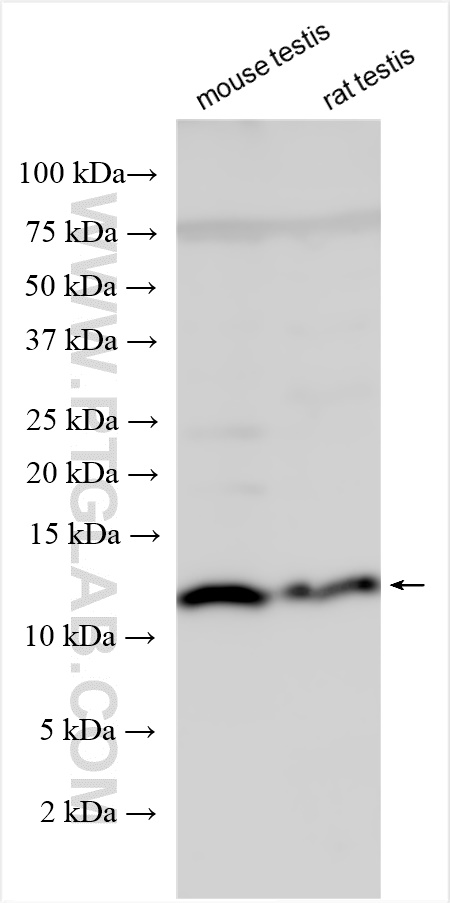验证数据展示
经过测试的应用
| Positive WB detected in | mouse testis tissue, rat testis |
推荐稀释比
| 应用 | 推荐稀释比 |
|---|---|
| Western Blot (WB) | WB : 1:200-1:1000 |
| It is recommended that this reagent should be titrated in each testing system to obtain optimal results. | |
| Sample-dependent, Check data in validation data gallery. | |
产品信息
27697-1-AP targets INSL5 in WB, ELISA applications and shows reactivity with mouse, rat samples.
| 经测试应用 | WB, ELISA Application Description |
| 经测试反应性 | mouse, rat |
| 免疫原 | INSL5 fusion protein Ag26833 种属同源性预测 |
| 宿主/亚型 | Rabbit / IgG |
| 抗体类别 | Polyclonal |
| 产品类型 | Antibody |
| 全称 | insulin-like 5 |
| 别名 | INSL5, insulin like 5, Insulin like peptide 5, Insulin like peptide INSL5, PRO182, UNQ156 |
| 观测分子量 | 12-15 kDa |
| GenBank蛋白编号 | BC101646 |
| 基因名称 | INSL5 |
| Gene ID (NCBI) | 10022 |
| RRID | AB_3085985 |
| 偶联类型 | Unconjugated |
| 形式 | Liquid |
| 纯化方式 | Antigen affinity purification |
| UNIPROT ID | Q9Y5Q6 |
| 储存缓冲液 | PBS with 0.02% sodium azide and 50% glycerol , pH 7.3 |
| 储存条件 | Store at -20°C. Stable for one year after shipment. Aliquoting is unnecessary for -20oC storage. |
背景介绍
Insulin-like peptide 5 (INSL5), also named as UNQ156/PRO182, is a member of the relaxin/insulin superfamily and presents a tertiary structure similar to that of other insulin family members. It is located outside the cell membranes and highly expressed in rectum with lower levels in uterus and ascending and descending colon (PMID: 10458910). The calculated molecular weight of INSL5 is 15 kDa. A recent report suggested an important role for Isnl5 in the regulation of insulin secretion and b-cell homeostasis. Other reports identified that colonic Isnl5 expression is reduced by the gut microbiota and energy availability. In human diseases, INSL5 has been identified recently in colonic tissue and neuroendocrine tumors, but its specific functions in tumors remain to be elucidated(PMID: 32657028).
实验方案
| Product Specific Protocols | |
|---|---|
| WB protocol for INSL5 antibody 27697-1-AP | Download protocol |
| Standard Protocols | |
|---|---|
| Click here to view our Standard Protocols |
